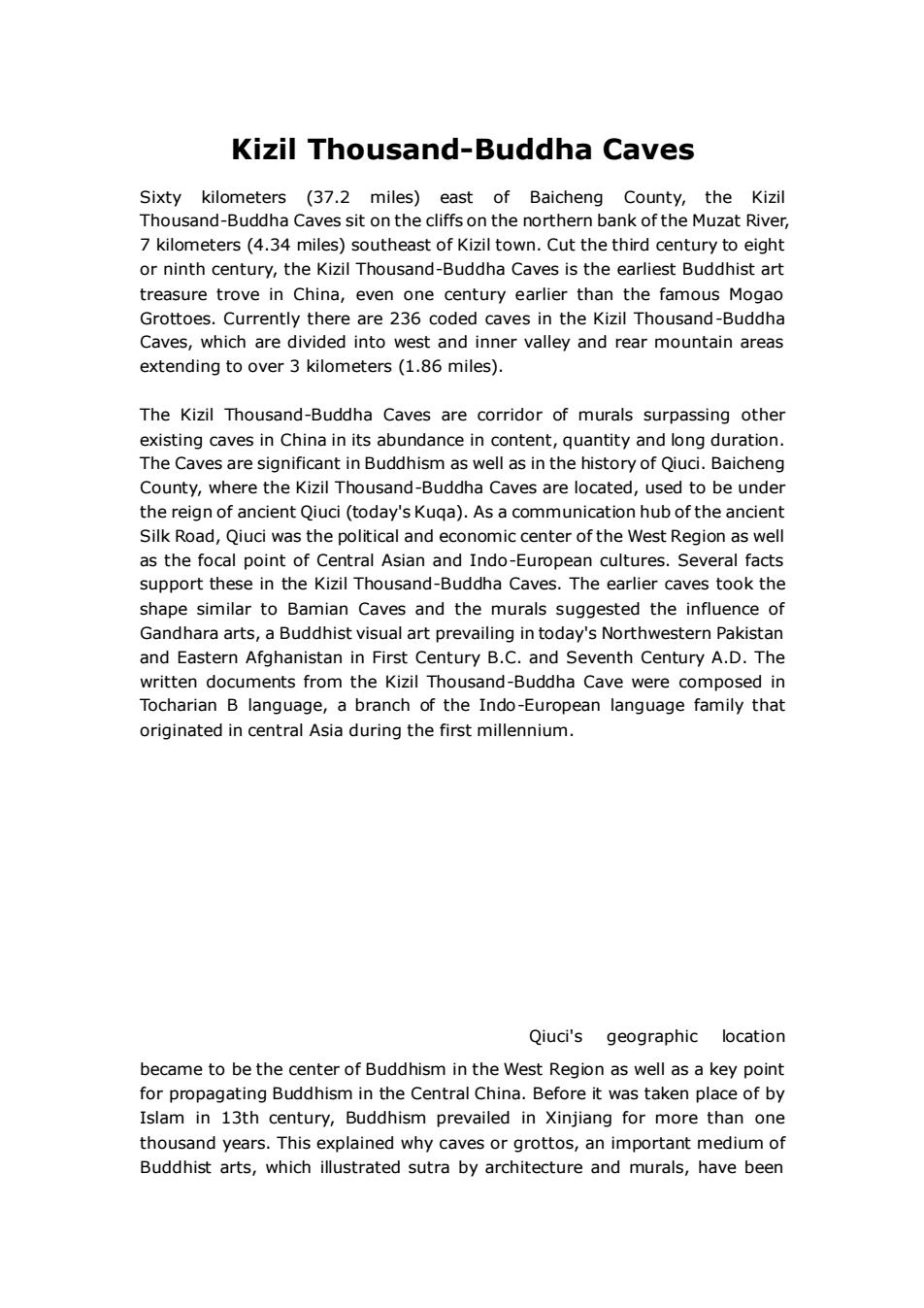
Kizil Thousand-Buddha Caves Sixty kilometers (37.2 miles)east of Baicheng County,the Kizil Thousand-Buddha Caves sit on the cliffs on the northern bank of the Muzat River, 7 kilometers(4.34 miles)southeast of Kizil town.Cut the third century to eight or ninth century.the kizil thousand-Buddha caves is the earliest buddhist art treasure trove in China,even one century earlier than the famous Moga Grottoes.Currently there are 236 coded caves in the Kizil Thousand-Buddha Caves,which are divided into west and inner valley and rear mountain areas extending to over 3 kilometers(1.86 miles). The Kizil Thousand-Buddha Caves are corridor of murals surpassing other existing caves in China in its abu ndance in content,quantity and long duration The Caves are significant in Buddhism as well as in the history of Qiuci.Baicheng County,where the Kizil Thousand-Buddha Caves are located,used to be under the reign of ancient Qiuci(today's Kuga).As a communication hub of the ancient Silk Road,Qiuci was the political and economic center of the West Region as well as the e focal point of C t0 I Asian ope res.Several fa support these in the Kizil Thousand-Buddha Caves.The earlier caves took the shape similar to Bamian Caves and the murals suggested the influence of Gandhara arts,a Buddhist visual art prevailing in today's Northwestern Pakistan and Eastern Afghanistan in First Century B.C.and Seventh Century A.D.The written docu nents from the Kizi and-Bu ddha Cav wer sed in Tocharian B language,a branch of the Indo-Europeananguage family that originated in central Asia during the first millennium. Qiuci's geographic location became to be the center of Buddhism in the West Region as well as a key point for propagating Buddhism in the Central China.Before it was taken place of by Islam in 13th century,Buddhism prevailed in Xinjiang for more than one thousand years.This explained why caves or grottos,an important medium of Buddhist arts,which illustrated sutra by architecture and murals,have been
Kizil Thousand-Buddha Caves Sixty kilometers (37.2 miles) east of Baicheng County, the Kizil Thousand-Buddha Caves sit on the cliffs on the northern bank of the Muzat River, 7 kilometers (4.34 miles) southeast of Kizil town. Cut the third century to eight or ninth century, the Kizil Thousand-Buddha Caves is the earliest Buddhist art treasure trove in China, even one century earlier than the famous Mogao Grottoes. Currently there are 236 coded caves in the Kizil Thousand-Buddha Caves, which are divided into west and inner valley and rear mountain areas extending to over 3 kilometers (1.86 miles). The Kizil Thousand-Buddha Caves are corridor of murals surpassing other existing caves in China in its abundance in content, quantity and long duration. The Caves are significant in Buddhism as well as in the history of Qiuci. Baicheng County, where the Kizil Thousand-Buddha Caves are located, used to be under the reign of ancient Qiuci (today's Kuqa). As a communication hub of the ancient Silk Road, Qiuci was the political and economic center of the West Region as well as the focal point of Central Asian and Indo-European cultures. Several facts support these in the Kizil Thousand-Buddha Caves. The earlier caves took the shape similar to Bamian Caves and the murals suggested the influence of Gandhara arts, a Buddhist visual art prevailing in today's Northwestern Pakistan and Eastern Afghanistan in First Century B.C. and Seventh Century A.D. The written documents from the Kizil Thousand-Buddha Cave were composed in Tocharian B language, a branch of the Indo-European language family that originated in central Asia during the first millennium. Qiuci's geographic location became to be the center of Buddhism in the West Region as well as a key point for propagating Buddhism in the Central China. Before it was taken place of by Islam in 13th century, Buddhism prevailed in Xinjiang for more than one thousand years. This explained why caves or grottos, an important medium of Buddhist arts, which illustrated sutra by architecture and murals, have been
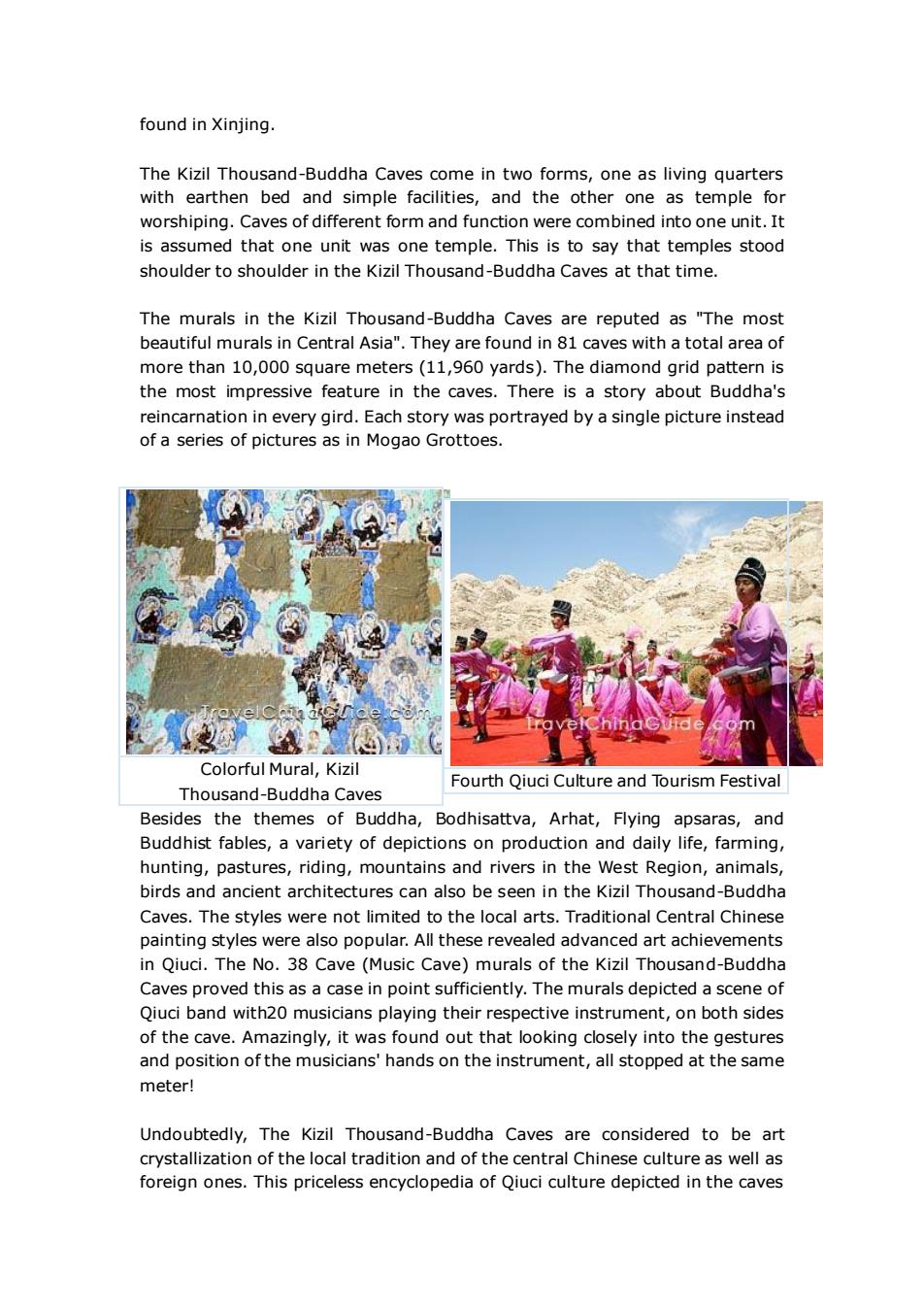
found in Xinjing. with earthen s come in two forms,one as living quarters one as temple for worshiping.Caves of different form and function were combined into one unit.It is assumed that one unit was one temple.This is to say that temples stood shoulder to shoulder in the Kizil Thousand-Buddha Caves at that time. The murals in the Kizil Thousand-Buddha Caves are reputed as"The most beautiful murals in Central Asia".They are found in 81 caves with a total area of more than 10,000 square meters(11,960 yards).The diamond grid pattern is the most impressive feature in the caves.There is a story about Buddha's every gird.Each story was portrayed by a single picture instead Colorful Mural,Kizil Thousand-BuddhaCaves Fourth Qiuci Culture and Tourism Festival Besid the themes of Buddha,Bodhisattva,Arhat,Flying apsaras,and Buddhist fables,a variety of depictions on production and daily life,farming, hunting,pastures,riding,mountains and rivers in the West Region,animals, birds and ancient architectures can also be seen in the kizil thousand-Buddha The styles were not limited to the local rts.Traditional Central Chine painting styles were also popula All these reveale dvanced art achie ements in Qiuci.The No.38 Cave (Music Cave)murals of the Kizil Thousand-Buddha Caves proved this as a case in point sufficiently.The murals depicted a scene of Qiuci band with20 musicians playing their respective instrument,on both sides of the cave.Amazingly,it was fo d out that looking closely into the gestures and position f the mu sicians'han n the instrument,all stopped at the meter! Undoubtedly,The Kizil Thousand-Buddha Caves are considered to be art crystallization of the local tradition and of the central Chinese culture as well as foreign ones.This priceles encyclopedia of Qiuci culture depicted in the caves
found in Xinjing. The Kizil Thousand-Buddha Caves come in two forms, one as living quarters with earthen bed and simple facilities, and the other one as temple for worshiping. Caves of different form and function were combined into one unit. It is assumed that one unit was one temple. This is to say that temples stood shoulder to shoulder in the Kizil Thousand-Buddha Caves at that time. The murals in the Kizil Thousand-Buddha Caves are reputed as "The most beautiful murals in Central Asia". They are found in 81 caves with a total area of more than 10,000 square meters (11,960 yards). The diamond grid pattern is the most impressive feature in the caves. There is a story about Buddha's reincarnation in every gird. Each story was portrayed by a single picture instead of a series of pictures as in Mogao Grottoes. Colorful Mural, Kizil Thousand-Buddha Caves Fourth Qiuci Culture and Tourism Festival Besides the themes of Buddha, Bodhisattva, Arhat, Flying apsaras, and Buddhist fables, a variety of depictions on production and daily life, farming, hunting, pastures, riding, mountains and rivers in the West Region, animals, birds and ancient architectures can also be seen in the Kizil Thousand-Buddha Caves. The styles were not limited to the local arts. Traditional Central Chinese painting styles were also popular. All these revealed advanced art achievements in Qiuci. The No. 38 Cave (Music Cave) murals of the Kizil Thousand-Buddha Caves proved this as a case in point sufficiently. The murals depicted a scene of Qiuci band with20 musicians playing their respective instrument, on both sides of the cave. Amazingly, it was found out that looking closely into the gestures and position of the musicians' hands on the instrument, all stopped at the same meter! Undoubtedly, The Kizil Thousand-Buddha Caves are considered to be art crystallization of the local tradition and of the central Chinese culture as well as foreign ones. This priceless encyclopedia of Qiuci culture depicted in the caves
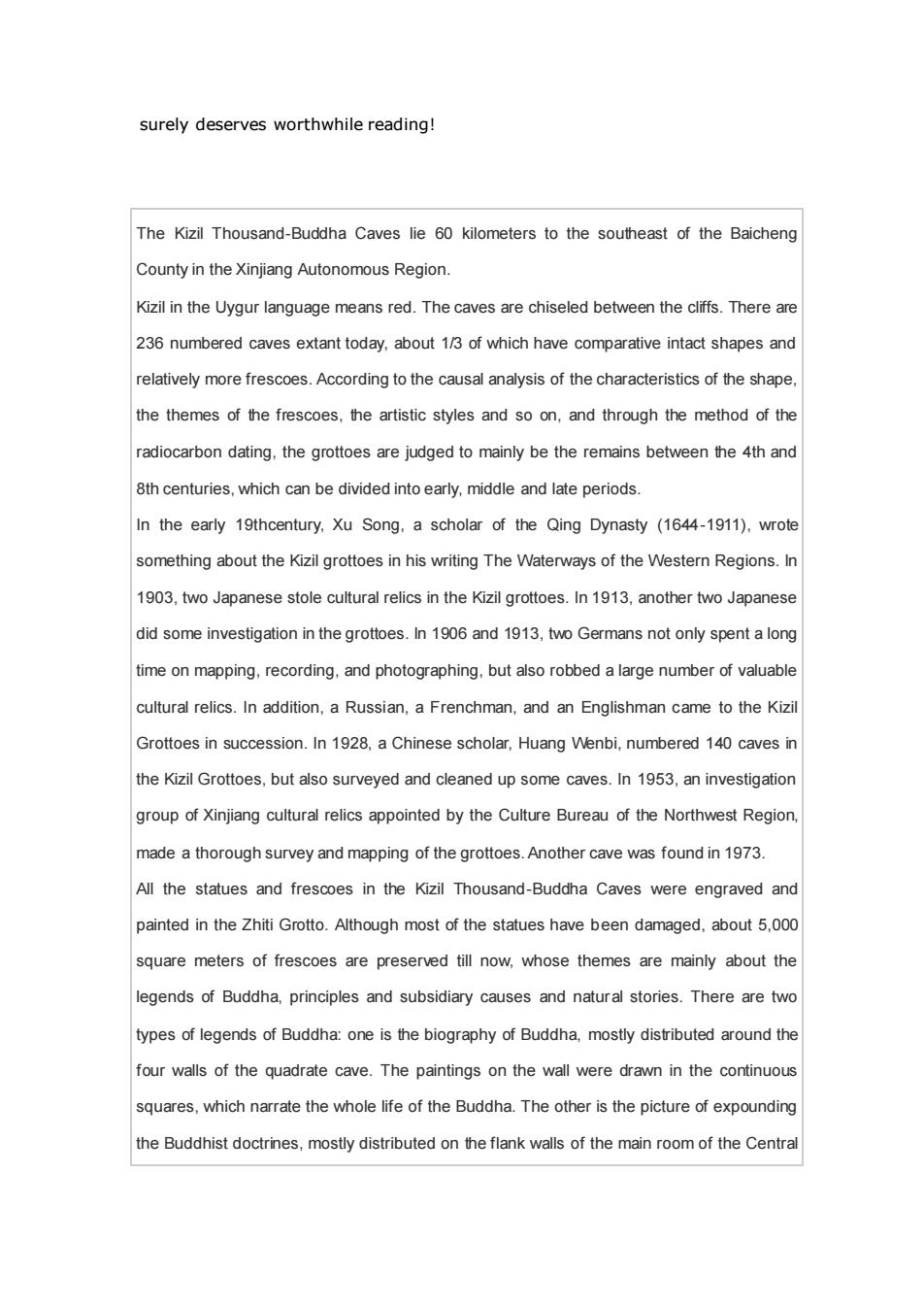
surely deserves worthwhile reading! The Kizil Thousand-Buddha Caves lie 60 kilometers to the southeast of the Baicheng County in the Xinjiang Autonomous Region. Kizil in the Uygur language means red.The caves are chiseled between the cliffs.There are 236 numbered caves extant today.about 1/3 of which have comparative intact shapes and relatively more frescoes.According to the causal analysis of the characteristics of the shape the themes of the frescoes,the artistic styles and and through the method of the radiocarbon dating.the grottoes are judged to mainly be the remains between the 4th and 8th centuries,which can be divided into early,middle and late periods. In the early 19thcentury.Xu Song.a scholar of the Qing Dynasty (1644-1911).wrote something about the Kizil grottoes in his writing The Waterways of the Western Regions.Ir 1903,two Japanese stole cultural relics in the Kizil grottoes.In1913,another two Japanese did some investigation in the grottoes.In 1906 and 1913,two Germans not only spent a long ime on mapping.recd graphing,but also robbed a large number of valuable cultural relics.In addition,a Russian,a Frenchman,and an Englishman came to the Kizi Grottoes in succession.In 1928.a Chinese scholar,Huang Wenbi,numbered 140 caves in the Kizil Grottoes,but also survey ed and clea aned up some caves.In 1953.an investigation group of Xinjiang cultur appointed by the Culture Bureau of the Northwest Regior made a thorough survey and mapping of the grottoes.Another cave was found in 1973. All the statues and frescoes in the Kizil Thousand-Buddha Caves were engraved and ainted in the Zhiti Grotto.Although most of the statues have been damaged,about 5.000 square meters of frescoes are preserved till now,whose themes are mainly about the legends of Buddha,principles and subsidiary causes and natural stories.There are two types of legends of Buddha:one is the biograph of Buddha,mostly distributed around the four walls of the quadrate cave.The paintings on the wall were drawn in the continuous squares,which narrate the whole life of the Buddha.The other is the picture of expounding the Buddhist doctrines.mostly distributed on the flank walls of the main room of the Central
surely deserves worthwhile reading! The Kizil Thousand-Buddha Caves lie 60 kilometers to the southeast of the Baicheng County in the Xinjiang Autonomous Region. Kizil in the Uygur language means red. The caves are chiseled between the cliffs. There are 236 numbered caves extant today, about 1/3 of which have comparative intact shapes and relatively more frescoes. According to the causal analysis of the characteristics of the shape, the themes of the frescoes, the artistic styles and so on, and through the method of the radiocarbon dating, the grottoes are judged to mainly be the remains between the 4th and 8th centuries, which can be divided into early, middle and late periods. In the early 19thcentury, Xu Song, a scholar of the Qing Dynasty (1644-1911), wrote something about the Kizil grottoes in his writing The Waterways of the Western Regions. In 1903, two Japanese stole cultural relics in the Kizil grottoes. In 1913, another two Japanese did some investigation in the grottoes. In 1906 and 1913, two Germans not only spent a long time on mapping, recording, and photographing, but also robbed a large number of valuable cultural relics. In addition, a Russian, a Frenchman, and an Englishman came to the Kizil Grottoes in succession. In 1928, a Chinese scholar, Huang Wenbi, numbered 140 caves in the Kizil Grottoes, but also surveyed and cleaned up some caves. In 1953, an investigation group of Xinjiang cultural relics appointed by the Culture Bureau of the Northwest Region, made a thorough survey and mapping of the grottoes. Another cave was found in 1973. All the statues and frescoes in the Kizil Thousand-Buddha Caves were engraved and painted in the Zhiti Grotto. Although most of the statues have been damaged, about 5,000 square meters of frescoes are preserved till now, whose themes are mainly about the legends of Buddha, principles and subsidiary causes and natural stories. There are two types of legends of Buddha: one is the biography of Buddha, mostly distributed around the four walls of the quadrate cave. The paintings on the wall were drawn in the continuous squares, which narrate the whole life of the Buddha. The other is the picture of expounding the Buddhist doctrines, mostly distributed on the flank walls of the main room of the Central
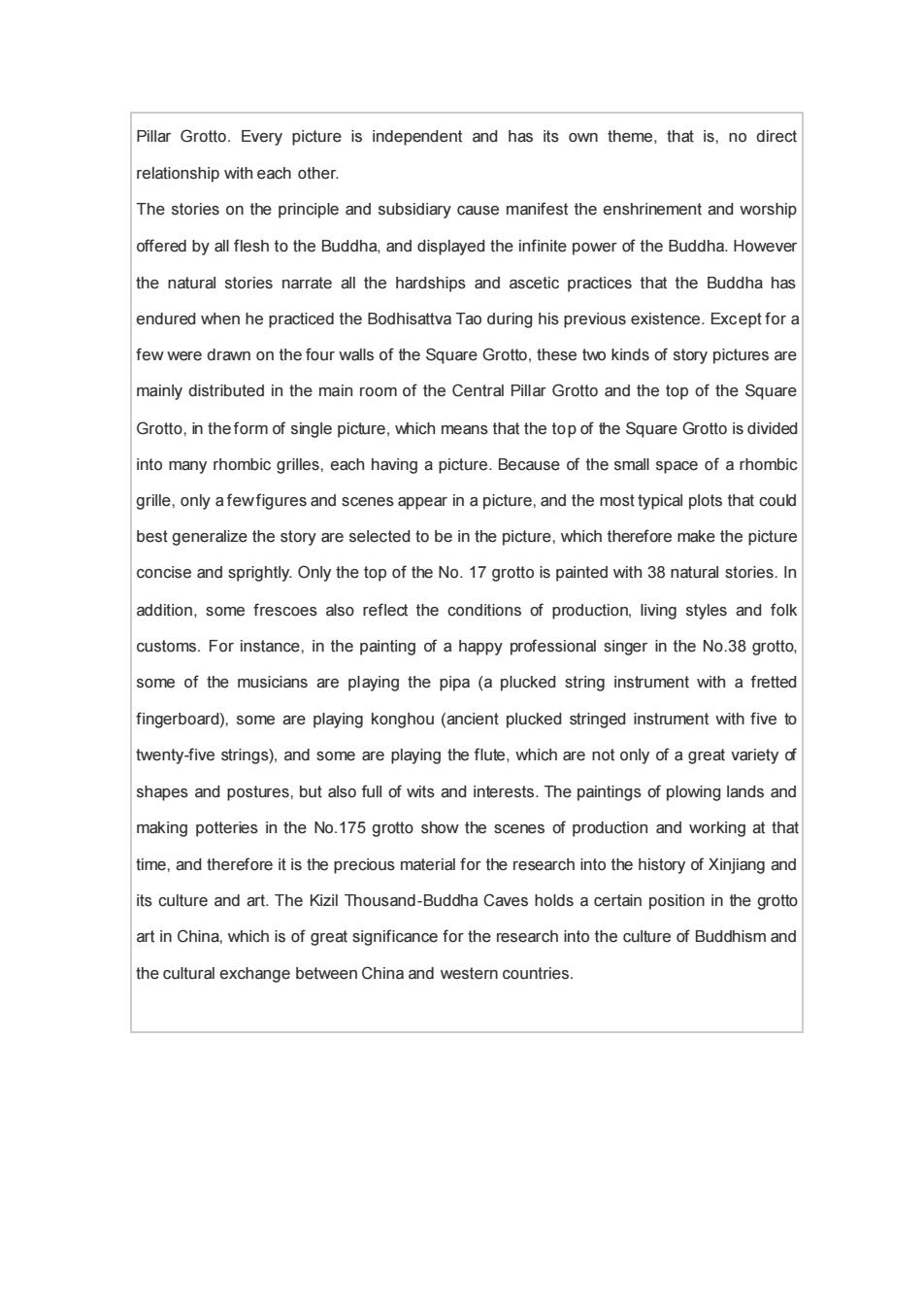
Pillar Grotto.Every picture is independent and has its own theme,that is,no direct elationship with each other The stories on the principle and subsidiary cause manifest the enshrinement and worship offered by all flesh to the Buddha,and displayed the infinite power of the Buddha.However the natural stories narrate all the hardships and ascetic practices that the Buddha has endured when he practiced the Bodhisattva Tao during his previous existence.Except for a few were drawn on the four walls of the Square Grotto,these two kinds of story pictures are mainly distributed in the main room of the Central Pillar Grotto and the top of the Square Grotto.in theform of single picture.which means that the top of the Square Grotto is divided into many rhombic grilles,each having a picture.Because of the small space of a rhombic grille,only afewfigures and scenes appear in a picture,and the most typical plots that could best generalize the story are selected to be in the picture.which therefore make the picture oncise and sprightly.Ony the top of the No.17groto is painted stories.In addition,some frescoes also reflect the conditions of production,living styles and folk customs.For instance,in the painting of a happy professional singer in the No.38 grotto. some of the musicians are playing the pipa(a plucked string instrument with a frette fingerboard),some are playing konghou (ancient plucked stringed instrument with five to twenty-five strings).and some are playing the flute.which are not only of a great variety df shapes and postures,but also full of wits and interests.The paintings of plowing lands and making potteries in the No.175 grotto show the scenes of production and working at tha time,and therefore it is the precious material for the research into the history of Xinjiang and its culture and art.The Kizil Thousand-Buddha Caves holds a certain position in the grotto art in China.which is of great significance for the research into the culture of Buddhism and the cultural exchange between China and westemn countries
Pillar Grotto. Every picture is independent and has its own theme, that is, no direct relationship with each other. The stories on the principle and subsidiary cause manifest the enshrinement and worship offered by all flesh to the Buddha, and displayed the infinite power of the Buddha. However the natural stories narrate all the hardships and ascetic practices that the Buddha has endured when he practiced the Bodhisattva Tao during his previous existence. Except for a few were drawn on the four walls of the Square Grotto, these two kinds of story pictures are mainly distributed in the main room of the Central Pillar Grotto and the top of the Square Grotto, in the form of single picture, which means that the top of the Square Grotto is divided into many rhombic grilles, each having a picture. Because of the small space of a rhombic grille, only a few figures and scenes appear in a picture, and the most typical plots that could best generalize the story are selected to be in the picture, which therefore make the picture concise and sprightly. Only the top of the No. 17 grotto is painted with 38 natural stories. In addition, some frescoes also reflect the conditions of production, living styles and folk customs. For instance, in the painting of a happy professional singer in the No.38 grotto, some of the musicians are playing the pipa (a plucked string instrument with a fretted fingerboard), some are playing konghou (ancient plucked stringed instrument with five to twenty-five strings), and some are playing the flute, which are not only of a great variety of shapes and postures, but also full of wits and interests. The paintings of plowing lands and making potteries in the No.175 grotto show the scenes of production and working at that time, and therefore it is the precious material for the research into the history of Xinjiang and its culture and art. The Kizil Thousand-Buddha Caves holds a certain position in the grotto art in China, which is of great significance for the research into the culture of Buddhism and the cultural exchange between China and western countries
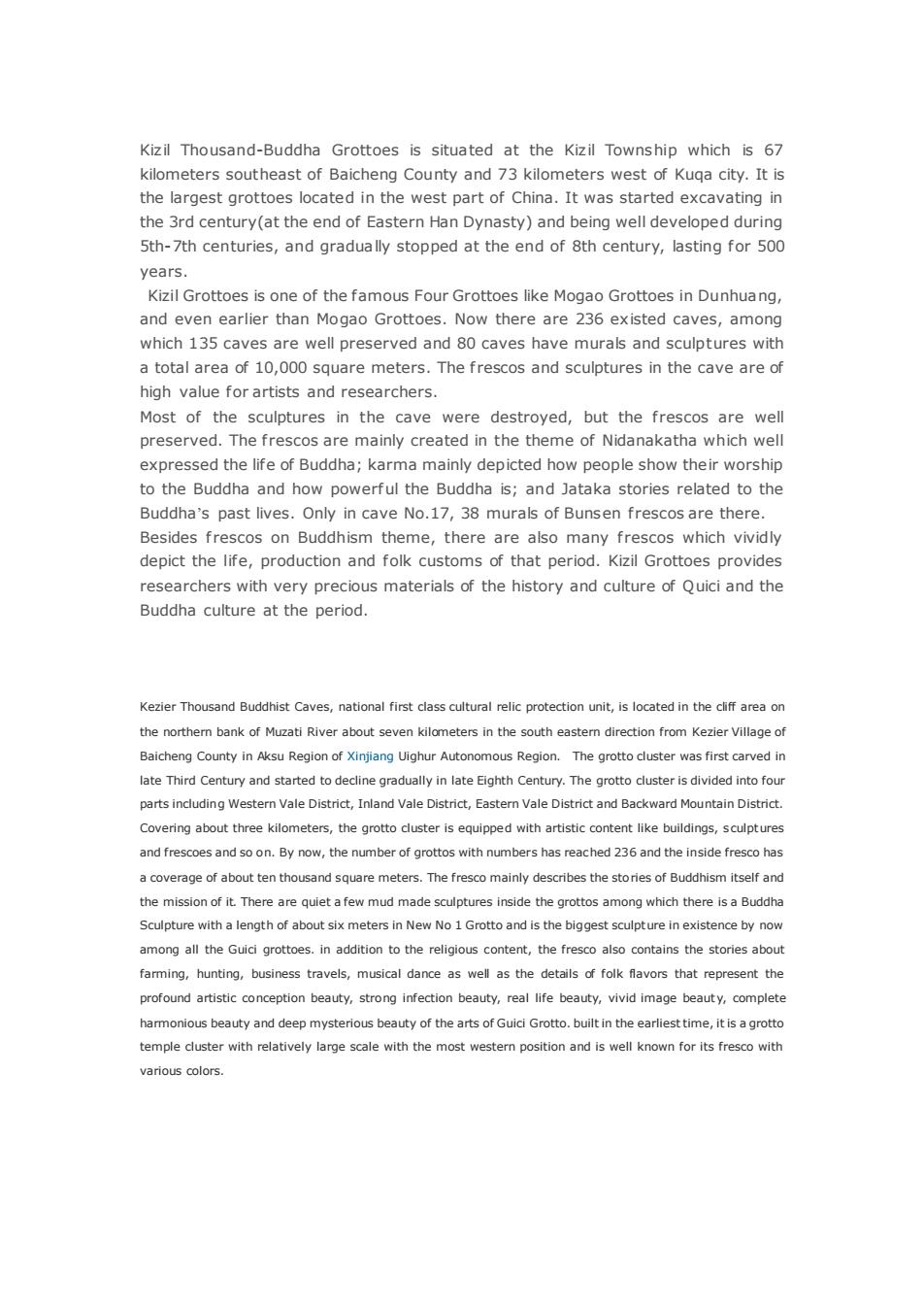
Kizil Thousand-Buddha Grottoes is situated at the Kizil Township which is 67 kilometers southeast of Baicheng County and 73 kilometers west of Kuqa city.It is the largest grottoes located in the west part of China.It was started excavating in the 3rd century(at the end of Eastern Han Dynasty)and being well developed during 5th-7th centuries.and gradually stopped at the end of 8th century,lasting for 500 tof the famou Four Grottoes ike o and even earlier than Mogao Grottoes.Now there are 236 existed caves,among which 135 caves are well preserved and 80 caves have murals and sculptures with a total area of 10,000 square meters.The frescos and sculptures in the cave are of high value for artists and researchers. Most of the sculptures in the cave were destroyed,but the frescos are wel preserved.The frescos are mainly created in the theme of Nidanakatha which wel expressed the life of Buddha;karma mainly depicted how people show their worship to the Buddha and how powerful the Buddha is;and Jataka stories related to the Buddha's past lives.Only in cave no.17.38 murals of Bunsen frescos are there. Besides frescos eme,there re also many cos which vividly depict the life,production and folk customs of that period.Kizil Grottoes provides researchers with very precious materials of the history and culture of Quici and the Buddha culture at the period. Kezier Thousand Buddhist Caves,national first dass cultural relic protection unit,is located in the northem bank of Muzati River about seven kilometers in the south eastemn direction from Kezier Village of Baicheng County in Aksu Region of Xinjiang Uighur Autonomous Region.The grotto cluster was first carved ir atsihnctdingwC dBackward Covering about three kilometers,thegroto cluster is equipped with artistic content like buildings,scuptures and frescoes and so on.By now,the number of grottos with numbers has reached 236 and the inside fresco has a coverage of about ten thousand square meters.The fresco mainly describes the stores of Buddhism itself and the mission of it.There are quiet a few mud made sculptures inside the grottos among which there is a Buddha gal the Gu.to the,the fresco ntains the stories a farming,hunting,business travels,musical dance as well as the details of folk flavors that represent the profound artistic conception beauty,strong infection beauty,real life beauty,vivid image beauty,complete hammonious beauty and deep mysterious beauty of the arts of Guici Grotto.built in the earliest time,it is a grotto temple cluster with relatively large scale with the most western position and is well known for its fresco with
Kizil Thousand-Buddha Grottoes is situated at the Kizil Township which is 67 kilometers southeast of Baicheng County and 73 kilometers west of Kuqa city. It is the largest grottoes located in the west part of China. It was started excavating in the 3rd century(at the end of Eastern Han Dynasty) and being well developed during 5th-7th centuries, and gradually stopped at the end of 8th century, lasting for 500 years. Kizil Grottoes is one of the famous Four Grottoes like Mogao Grottoes in Dunhuang, and even earlier than Mogao Grottoes. Now there are 236 existed caves, among which 135 caves are well preserved and 80 caves have murals and sculptures with a total area of 10,000 square meters. The f rescos and sculptures in the cave are of high value for artists and researchers. Most of the sculptures in the cave were destroyed, but the f rescos are well preserved. The f rescos are mainly created in the theme of Nidanakatha which well expressed the life of Buddha; karma mainly depicted how people show their worship to the Buddha and how powerful the Buddha is; and Jataka stories related to the Buddha’s past lives. Only in cave No.17, 38 murals of Bunsen f rescos are there. Besides f rescos on Buddhism theme, there are also many f rescos which vividly depict the life, production and folk customs of that period. Kizil Grottoes provides researchers with very precious materials of the history and culture of Quici and the Buddha culture at the period. Kezier Thousand Buddhist Caves, national first class cultural relic protection unit, is located in the cliff area on the northern bank of Muzati River about seven kilometers in the south eastern direction from Kezier Village of Baicheng County in Aksu Region of Xinjiang Uighur Autonomous Region. The grotto cluster was first carved in late Third Century and started to decline gradually in late Eighth Century. The grotto cluster is divided into four parts including Western Vale District, Inland Vale District, Eastern Vale District and Backward Mountain District. Covering about three kilometers, the grotto cluster is equipped with artistic content like buildings, sculptures and frescoes and so on. By now, the number of grottos with numbers has reached 236 and the inside fresco has a coverage of about ten thousand square meters. The fresco mainly describes the stories of Buddhism itself and the mission of it. There are quiet a few mud made sculptures inside the grottos among which there is a Buddha Sculpture with a length of about six meters in New No 1 Grotto and is the biggest sculpture in existence by now among all the Guici grottoes. in addition to the religious content, the fresco also contains the stories about farming, hunting, business travels, musical dance as well as the details of folk flavors that represent the profound artistic conception beauty, strong infection beauty, real life beauty, vivid image beauty, complete harmonious beauty and deep mysterious beauty of the arts of Guici Grotto. built in the earliest time, it is a grotto temple cluster with relatively large scale with the most western position and is well known for its fresco with various colors